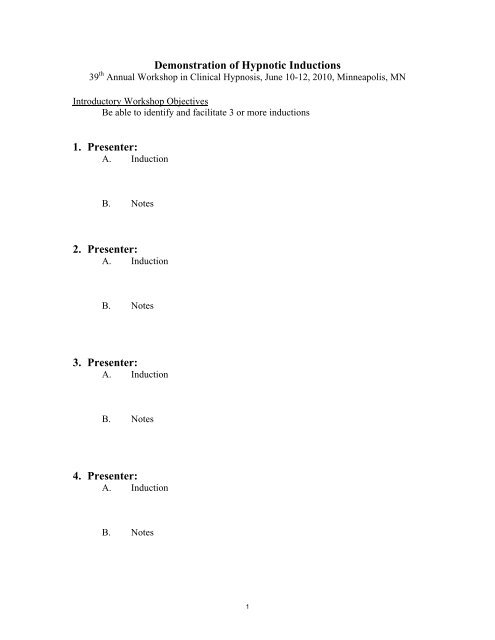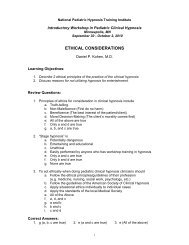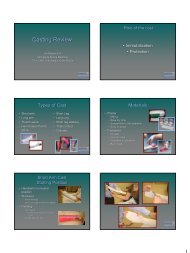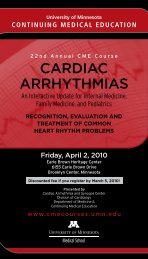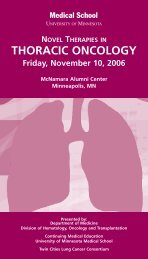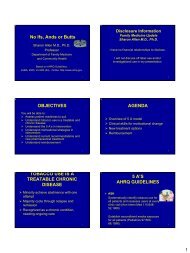Demonstration of Hypnotic Inductions 1. Presenter: 2. Presenter: 3 ...
Demonstration of Hypnotic Inductions 1. Presenter: 2. Presenter: 3 ...
Demonstration of Hypnotic Inductions 1. Presenter: 2. Presenter: 3 ...
Create successful ePaper yourself
Turn your PDF publications into a flip-book with our unique Google optimized e-Paper software.
<strong>Demonstration</strong> <strong>of</strong> <strong>Hypnotic</strong> <strong>Inductions</strong><br />
39 th Annual Workshop in Clinical Hypnosis, June 10-12, 2010, Minneapolis, MN<br />
Introductory Workshop Objectives<br />
Be able to identify and facilitate 3 or more inductions<br />
<strong>1.</strong> <strong>Presenter</strong>:<br />
A. Induction<br />
B. Notes<br />
<strong>2.</strong> <strong>Presenter</strong>:<br />
A. Induction<br />
B. Notes<br />
3. <strong>Presenter</strong>:<br />
A. Induction<br />
B. Notes<br />
4. <strong>Presenter</strong>:<br />
A. Induction<br />
B. Notes<br />
1
PROGRESSIVE RELAXATION INDUCTION<br />
D. Corydon Hammond, Ph.D.<br />
University <strong>of</strong> Utah School <strong>of</strong> Medicine<br />
FIXATION ON BODY AND BREATHING<br />
I’d like you to begin by just resting back, very comfortably, and closing your<br />
eyes. Just rest back in the way that is most comfortable for you right now, just resting<br />
your hands on your thighs, or on the arms <strong>of</strong> the chair. And as you just settle back<br />
comfortably, this will be an opportunity, for you to become even more comfortable, and<br />
to experience a hypnotic state, very easily, and very gently.<br />
And as you rest back, you can begin noticing the feelings, and sensations in your<br />
body right now. Just notice some <strong>of</strong> the sensations, that you can be aware <strong>of</strong> right now.<br />
For instance, you may become aware <strong>of</strong> the feelings in your feet; or you may notice the<br />
sensations in your hands as they rest there. And as you continue listening to me, I’d like<br />
you to simply allow yourself to breath easily and comfortably. And as you do so, you<br />
can pay particular attention to your breathing. Just pay particular attention, to the<br />
sensations associated with every breath you take. And as you attend to those feelings,<br />
you can notice that the sensations are different, when you breath in [timed to inhalation],<br />
and when you breathe out [timed to exhalation]. Just notice those feelings as you breathe<br />
in [timed to inhalation], and fill your lungs; and then notice the sense <strong>of</strong> release, as you<br />
breathe out [said while exhaling simultaneously with the patient], and allow more<br />
comfort to come into your experience.<br />
PROGRESSIVE RELAXATION<br />
And now I’d like you to concentrate particularly on the feelings in your toes and<br />
feet. Just allow all the muscles and fibers in your toes and feet, to become very deeply<br />
relaxed. Perhaps even picturing in your mind’s eye what that would look like, for all<br />
those little muscles and tissues to relax, loosely and deeply. Allowing yourself to get that<br />
kind <strong>of</strong> feeling you have, when you take <strong>of</strong>f a pair <strong>of</strong> tight shoes, that you’ve had on for a<br />
long time. And you can just let go <strong>of</strong> all the tension in your toes and feet, and feel the<br />
relaxation spread. [brief pause]<br />
And now imagine that this comfort and relaxation, is beginning to flow, like a<br />
gentle river <strong>of</strong> relaxation, upward, through your ankles and into your calves. Let go <strong>of</strong> all<br />
the tension in your calves, allowing them to deeply, and restfully, and comfortably relax.<br />
And when it feels as if that comfort has spread all the way up to your knees, gently nod<br />
your head to let me know [pause] [After a response]: Good. [This signal is a double<br />
check that the patient is responding adequately and it also allows the facilitator to gauge<br />
the amount <strong>of</strong> time needed for purposes <strong>of</strong> timing the rest <strong>of</strong> the induction. A signal may<br />
also be given at the top <strong>of</strong> the thighs].<br />
2
And allow that comfort to continue, flowing upward, into your knees, and behind<br />
your knees and through your knees, and into your thighs. Letting go <strong>of</strong> all the tension in<br />
your thighs, perhaps once again imagining what that might look like, for all those large<br />
muscles and tissues, to become s<strong>of</strong>t and loose, deeply relaxed. Perhaps already noticing<br />
that sense <strong>of</strong> gentle heaviness in your legs, as they just sink down, limply and<br />
comfortably. And when you notice that sense <strong>of</strong> heaviness in your legs, gently nod your<br />
head again.<br />
And continue to allow that comfort, to flow and spread upward, at its own pace<br />
and speed, into the middle part <strong>of</strong> your body. Flowing into your pelvis and abdomen and<br />
stomach, [pause] through your hips and into lower back. Letting that soothing, deep<br />
comfort spread, inch by inch, up through your body. Spreading from muscle group to<br />
muscle group. Gradually, progressively flowing into your chest, [brief pause] into your<br />
back, [brief pause], between your shoulder blades, and into your shoulders. Just allow all<br />
the tension to loosen, and flow away. As if somehow, just the act <strong>of</strong> breathing is<br />
increasing your comfort. As if somehow, every breath you take, is just draining the<br />
tension out, <strong>of</strong> your body, taking you deeper, [timed to exhalations] and deeper, into<br />
comfort, with every breath you take.<br />
And allow that comfort to flow into your neck and throat. Perhaps imagining<br />
once again what that would look like, for all the little fibers and muscles in your neck and<br />
throat, to deeply, s<strong>of</strong>tly, comfortably relax. Let that relaxation sink deep into your neck.<br />
And it can gradually flow up your neck, up into your scalp, and all Out across your scalp,<br />
as if it’s just bathing your head, with waves <strong>of</strong> comfort, and relaxation. And that<br />
relaxation can flow down, into your forehead, and like a gentle wave, down across your<br />
face, into your eyes, your cheeks, your mouth and jaw. Just let go <strong>of</strong> all the tension in<br />
your face, your mouth, your jaw, allowing those tissues and muscles to sag down, slack<br />
and relaxed.<br />
And now allow that comfort to flow back down your neck, and across your<br />
shoulders, and down into your arms. Letting that comfort flow down your arms, through<br />
your elbows, [pause] through your wrists, through your hands and fingers, right down<br />
through your fingertips. Letting go <strong>of</strong> all the tension, and tightness, letting go <strong>of</strong> all the<br />
stress, and strain, all through your body. Just allowing your body to rest, and relax.<br />
3
Progressive Yoga Relaxation Induction<br />
© Stephen Parker Psy.D. L.P. R.Y.T. 500<br />
This hypnotic induction is borrowed from the large and detailed science <strong>of</strong> deep<br />
relaxation exercises in the yoga tradition that goes by the name shīthali-karaņa. There are<br />
literally hundreds <strong>of</strong> different forms, which operate under the general principle that the<br />
more points <strong>of</strong> concentration there are, the deeper the state <strong>of</strong> relaxation that is obtained.<br />
These exercises are used in training for entering deep states <strong>of</strong> meditation and are<br />
sometimes combined with a complementary set <strong>of</strong> practices called yoga-nidrā or yoga<br />
sleep, through which one can accomplish the outcomes <strong>of</strong> traditional hypnosis and,<br />
beyond this, can come to a state <strong>of</strong> conscious delta wave sleep 1 .<br />
Just make yourself comfortable on the couch and feel the couch supporting your<br />
body. If any part <strong>of</strong> your body feels tight or tense, just pick it up, tense it a bit, relax and<br />
set it back down again. As we begin, just feel your body from head to toe from inside<br />
your skin. You may feel your eyes want to close at some point to help you do this and if<br />
that happens, go right ahead. Bring your mind back from all the space around you and<br />
feel just the space your body occupies inside your skin. As you do this, it’s interesting<br />
how aware you become <strong>of</strong> your breathing, feeling your body move as you breathe. For a<br />
few moments just observe this process. Feel how much you use the muscles in your chest<br />
. . . . or your stomach . . . . or your shoulders in the process <strong>of</strong> breathing and just enjoy<br />
how comfortable you feel. Notice how your breath has begun to become just a little<br />
slower and deeper as you observe and just let that process continue. Feel the flow <strong>of</strong><br />
breath in your nostrils, warm as you exhale, cool as you inhale, and let that feeling <strong>of</strong><br />
flow in your nostrils help you make your breath very smooth and deep and even. And you<br />
can even see if you can smooth over the pause between exhaling and inhaling. (Pause for<br />
a couple <strong>of</strong> breaths.) Good!<br />
Now, as you focus on feeling your body breathe, let yourself feel inside the<br />
muscles <strong>of</strong> your chest and shoulders and feel inside the center <strong>of</strong> any tension you find<br />
there until the muscles just let go. Relax your shoulders and your chest and let yourself<br />
exhale by gently pushing the air out with the muscles in your stomach and diaphragm and<br />
then relax and just let the air fill you as you inhale. So you make exhalation the active<br />
part <strong>of</strong> your breathing cycle. And its interesting how as you breath you can feel a little<br />
more relaxed and comfortable with each exhaling breath.<br />
And now let yourself feel your way through the muscles in your body as I name<br />
them and see whether you notice any tightness or tension, and, just as before, let your<br />
mind feel inside the center <strong>of</strong> any tension you find until the muscles just let go. So feel<br />
with your mind inside the muscles <strong>of</strong> your forehead and the top <strong>of</strong> your head, feel inside<br />
the center <strong>of</strong> any tension you find until the muscles relax and release. Relax your<br />
forehead and feel down around your eyes and eyebrows.<br />
1 This was demonstrated at the Menninger Foundation’s Voluntary Controls Project in 1970 by Swami<br />
Rama <strong>of</strong> the Himalayas. (For a general description <strong>of</strong> these experiments, see Green, Elmer and Alyce.<br />
(1977). Beyond bi<strong>of</strong>eedback. New York: Dell) and was recently demonstrated again in the laboratories <strong>of</strong><br />
the Institute <strong>of</strong> Noetic Sciences by his disciple Swami Veda Bharati.<br />
4
[Follow the same procedure as indicated above, interspersing the suggestion about<br />
becoming more and more comfortable with each exhalation: cheeks and the corner <strong>of</strong><br />
your mouth, jaw, neck, shoulders, upper arms, forearms, hands, fingers, fingertips,<br />
fingers, hands, forearms, upper arms, shoulders, chest—ribs and back, cardiac plexus in<br />
the center <strong>of</strong> the chest, abdomen and diaphragm, hips, behind (use neutral terms for body<br />
parts in proximity to genitals or other erogenous zones), thighs, lower legs and calf<br />
muscles, feet, and toes.] Now breathe as though you can feel your whole body breathing<br />
from head to toe. [Pause to allow a couple <strong>of</strong> breaths and then go up the body in the<br />
reverse order. If time is short, you can have the client feel from their shoulders to their<br />
fingertips and back again at their own speed rather than naming each part within that<br />
range.]<br />
Once again let yourself feel as though your whole body is breathing from head to<br />
toe. And now let yourself just feel the flow <strong>of</strong> breath in your nostrils at the spot where<br />
your nosebridge meets your upper lip. And as you focus your awareness here you can just<br />
feel how you can become more and more deeply comfortable and more and more deeply<br />
focused with each breath. It’s almost like you take a step with each breath into a deeper<br />
and deeper place, a place that is more and more comfortable, more and more safe, more<br />
and more just your own inner space. [Here you might facilitate deepening by counting the<br />
steps with each exhalation and interspersing deepening suggestions. When you have<br />
finished your utilization, facilitate exit from trance by counting backwards from the same<br />
number <strong>of</strong> steps you used in the induction, pairing your counting with each inhaling<br />
breath and the suggestion that with each inhaling breath the client can feel more and more<br />
awake and aware and refreshed until their eyes naturally want to open.]<br />
5
“Church/Steeple” Induction Technique<br />
The 39 th Annual Workshop in Clinical Hypnosis, June 10-12, 2010, Minneapolis, MN<br />
Make yourself comfortable in the chair, then extend your arms completely out so your hands are about eye level,<br />
like this (demonstrate arms extended). Good, now fold your fingers under at the second knuckle, all except your<br />
index fingers... extend them up, parallel to each other. like this (demonstrate fingers folded under, not laced, and<br />
index fingers about three inches apart).<br />
Good. Now I’d like you to just let your eyes focus on your fingers…as you do you’ll notice something very<br />
interesting beginning to happen: your fingers begin to come together almost as though they were being pulled<br />
together by magnets. (As fingers begin coining together, reinforce with “that’s fine, good”)<br />
And when your fingers touch feel a wave <strong>of</strong> relaxation sweep over you, and let your hands drift into your lap, and let<br />
your eyelids close.., that’s good. And now begin to concentrate on your breathing, breathing as slowly and as deeply<br />
as is comfortable for you. With each breath in feel a little more relaxed; with each breath out, a little <strong>of</strong> the tension<br />
<strong>of</strong> the day goes with it.<br />
Good, And as you continue to breath slowly and deeply I’d like you to begin to focus on various muscles, letting<br />
them relax. Begin with the muscles <strong>of</strong> your scalp and face, let them s<strong>of</strong>ten…the muscles <strong>of</strong> your neck and shoulders<br />
...let the tension <strong>of</strong> your head, neck and shoulders drain down your arms and out your fingertips... you may notice a<br />
very pleasant sensation as the tension drains through and out your fingertips: they may tingle or feel warm or<br />
wooden, I’m not sure what it will be, but it will he very pleasant.<br />
Now, at your own pace, focus on the muscles <strong>of</strong> your chest and back: let the tension drain out <strong>of</strong> them, the muscles<br />
<strong>of</strong> your abdomen and buttocks; let all <strong>of</strong> the tension <strong>of</strong> your trunk just drain down your legs and out your toes, And<br />
again, you may feel a tingling, numbness, or warmth spread through your feet as the tension drains away.<br />
That’s good. And now, when you are ready, at your own pace, open that part <strong>of</strong> your mind that stores beautiful<br />
memories, and return to a special place <strong>of</strong> comfort. This is a place which is always with you, a place where you can<br />
go to relax and do any work that you need to do.<br />
And when you are ready, at your own pace and in your own way, you can come back to the here and now, feeling<br />
deeply relaxed, alert and confident.<br />
6
<strong>Hypnotic</strong> Induction Technique: Sand Pail and Balloons<br />
Daniel P. Kohen, M.D.<br />
39th Annual Workshop in Clinical Hypnosis, June 10-12, 2010, Minneapolis, MN<br />
(adapted and modified from Kay Thompson, D.D.S.)<br />
(Note: This technique incorporates elements <strong>of</strong> catalepsy, levitation, reverse levitation,<br />
and Ericksonian suggestion; and allows the subject to demonstrate to themselves the<br />
wonderful capacity that they have for hypnotic ability.)<br />
Introduction: In a moment when I ask you to close your eyes and extend your arms in<br />
front <strong>of</strong> you, this is what I mean by extend your arms. (Clinician demonstrates arms<br />
extended straight out in front, parallel to the ground.) When we are doing this together,<br />
will it be okay if I touch you gently on your hands and/or arms? Thank-you.<br />
Verbalization:<br />
"Okay, let's begin. Please close your eyes and extend your arms. That's right."<br />
"Great. Now, it will be very interesting to imagine -- or pretend, whichever you prefer --<br />
that on one <strong>of</strong> your wrists there is hanging a child's sand pail, perhaps like the kind you<br />
used to have when you played at the lake or beach when you were much younger...and on<br />
the other wrist imagine that there is a large cluster <strong>of</strong> helium-filled balloons rising from a<br />
string tied gently around your wrist."<br />
"It doesn't matter which is which...but just notice now which is which. And....as you<br />
notice this difference, you will probably soon notice that the wrist with the helium filled<br />
balloons is exerting a slight gentle tug upward, lifting your hand and arm up, ever so<br />
slightly, "(and when it is different, then the clinician should add..."That's right...") "and<br />
you may have noticed that the hand with the pail on it is probably being tugged<br />
downward somewhat."<br />
(Pause for the suggestions to take effect. If no effect is noted, be patient, and perhaps<br />
<strong>of</strong>fer the motivating suggestion that "It's interesting to just let it happen and be curious<br />
about how it will feel and what you will notice.... that's right...good! ")<br />
"Now, in your imagination add a few clumps <strong>of</strong> dirt to the pail...and notice that this will<br />
make it a bit heavier, and you may feel that sensation <strong>of</strong> heaviness travel somewhat up<br />
7
your arm and into your shoulder."<br />
"Now, as the hand with the balloons seems to float up more and more at the right speed<br />
for you, it's interesting and kind <strong>of</strong> exciting to know that you are doing this so well,<br />
....and that it means that you are even better at learning self-hypnosis than you thought.<br />
And, you can go more and more into the comfort <strong>of</strong> this self-hypnosis experience the<br />
higher that hand floats, and more comfortable the lower the other hand goes, as it gets<br />
heavier and heavier ... holding up that pail now almost full <strong>of</strong> sand..."<br />
"It is <strong>of</strong>ten very interesting to not only enjoy this good feeling <strong>of</strong> learning, but also to<br />
learn that you can open your eyes while you are in hypnosis...so in a moment let your<br />
eyes open and enjoy seeing the differences that you feel and have created with your<br />
hands,....and after you do so you can feel very pleased.... and proud.... and let your eyes<br />
gently close again, going even more comfortably into your hypnosis. .........that's<br />
right.....isn't that great? ......Good...."<br />
Ending the trance with positive suggestions:<br />
"For the last part <strong>of</strong> this wonderful hypnotic experience, when you're ready let the hand<br />
with the pail just gently come toward your lap, let the pail slide <strong>of</strong>f onto the ground, and<br />
when your hand reaches your lap it can return to its usual regular and comfortable<br />
feelings. And, when you are clear that you have learned something very nice and<br />
interesting, then you can imagine cutting the string to the helium balloons, and as your<br />
hand floats gently down back to your lap and the balloons float away, that hand too can<br />
resume it's usual feeling. With both <strong>of</strong> your hands and arms back to their usual<br />
sensations, the rest <strong>of</strong> you can come back to your usual state <strong>of</strong> awareness when you're<br />
ready over the next few moments...and be sure to bring your comfortable good feelings<br />
back with you."<br />
"Very nicely done. Would you tell me about this experience?"<br />
8


